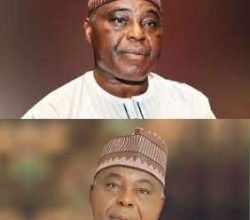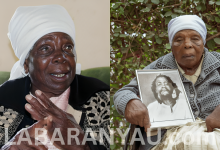
John Madden Biography
John Earl Madden was an American football coach and sports pundit for the National Football League (NFL) who died on December 28, 2021 (April 10, 1936). From 1969 until 1978, he was the Oakland Raiders’ head coach. Under his direction, the team made eight postseason appearances, won seven division titles, appeared in seven AFL/AFC Championship Games, and won its first Super Bowl in Super Bowl XI. Among NFL head coaches who have overseen at least 100 games, Madden has the greatest winning percentage thanks to his perfect record.
Madden worked as a color commentator for NFL telecasts from 1979 through 2008 when he stopped coaching, earning him 16 Sports Emmy Awards in the process. Madden provided commentary for games that were televised on CBS, Fox, ABC, and NBC on all four of the major American television networks. Additionally, he contributed his name, knowledge, and commentary to the Madden NFL video game franchise (1988–present), which grew to become the most successful football video game franchise ever. 2006 saw Madden’s induction into the Pro Football Hall of Fame.
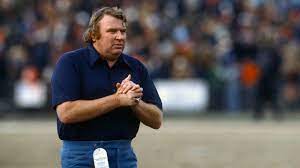
John Madden Early life
John Earl Madden, the son of Earl Russell Madden (1905–1961) and Mary (née Flaherty) Madden (1917–2011), was born in Austin, Minnesota, on April 10, 1936. When John was a little boy, his father, an auto technician, relocated the Madden family to Daly City, California, which is a city south of San Francisco. John Robinson[4] and I both attended Our Lady of Perpetual Help, a Catholic private school, where John graduated in 1950. After that, we both attended Jefferson High School, where John graduated in 1954.
John Madden Playing career
Madden, a high school football hero, played for one season in 1954 at the College of San Mateo before receiving a football scholarship to the University of Oregon, where he played football with his childhood friend John Robinson while also studying pre-law. Due to a knee injury and surgery, he was forced to redshirt. He next enrolled at the College of San Mateo in 1955, played football there in the fall of 1956, then transferred to Cal Poly in San Luis Obispo, where he played both offense and defense for the Mustangs in 1957 and 1958. He also earned a Bachelor of Science in education in 1959 and a Master of Arts in education in 1961 while attending these institutions.
Madden’s final thesis at Cal Poly examined how weightlifting might improve speed and strides in athletic training.
In his first year at Cal Poly, he earned a spot on the first team of the conference at offensive tackle and played catcher for the Mustangs baseball team. Following his junior season in 1957, Madden was chosen by United Press International for Little All-Coast Second Team honors. He was well-known among his colleagues for his outstanding downfield speed for a lineman. Bobby Beathard, a quarterback for Cal Poly and a future co-inductee into the Pro Football Hall of Fame, passed to Madden during the 1957 campaign.
The Philadelphia Eagles of the NFL selected Madden in the 21st round, 244th overall, in 1958, months before the start of his senior year at Cal Poly. In October 1958, with four games left on the schedule, Madden suffered a season-ending collarbone injury while making a tackle against Long Beach State, terminating his senior season, which once more saw him frequently start on the left side of the offensive line.
But on January 3, 1959, Madden participated in the All-American Bowl in Tucson, Arizona, and was afterwards complimented for his performance by Lou Pavlovich of The Sporting News. But in his first training camp, during an Eagles scrimmage in August 1959, he then had an injury to his second knee, ending his playing career before he had the chance to participate in a professional regulation game.
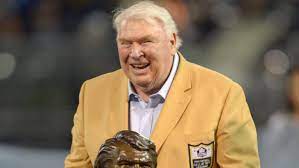
John Madden Coaching career
College coaching
Madden recalled his journey into coaching as follows:
“I had a knee injury in my debut season with the Philadelphia Eagles and was unable to participate. Norm Van Brocklin would watch movies while I was in recovery and would explain what was going on. My passion of football and teaching ultimately led me to earn a degree in education.
He joined Allan Hancock College in Santa Maria, California, as an assistant coach in 1960. In 1962, he received a promotion to head coach. Including an 8-1 record in 1963, when his Bulldogs were ranked No. 9 nationally among city institutions, Madden went 12-6 in two seasons. He was employed by San Diego State as a defensive assistant coach after the 1963 campaign and remained there through the end of the 1966 campaign. The 1966 Aztecs were one of the best minor universities in the nation during that last season. Don Coryell, a coach Madden worked with at San Diego State, had an impact on him as a coach, according to Madden.
Professional coaching with the Oakland Raiders
Building on that achievement, Al Davis recruited Madden as the linebackers coach for the AFL’s Oakland Raiders in 1967, placing him in the coaching pecking order of Sid Gillman. That year, he contributed to the team’s trip to Super Bowl II. On February 4, 1969, Madden was elected head coach of the Raiders, making him the AFL/NFL’s youngest head coach at the time at the age of 32. A year before, head coach of the Raiders John Rauch had left to accept the same post with the Buffalo Bills.
In 1969, Madden’s first Raiders team went 12-1-1 but fell to the Kansas City Chiefs 17-7 in the last AFL Championship game. Throughout Madden’s coaching tenure, this would develop into a tiresome pattern. During his 10 seasons as head coach, Oakland consistently maintained a winning record and won seven AFC West division titles, but they also suffered losses in six AFL/AFC Championship Games.
In 1969, Madden’s first Raiders team went 12-1-1 but fell to the Kansas City Chiefs 17-7 in the last AFL Championship game. Throughout Madden’s coaching tenure, this would develop into a tiresome pattern. During his 10 seasons as head coach, Oakland consistently maintained a winning record and won seven AFC West division titles, but they also suffered losses in six AFL/AFC Championship Games.
The Raiders finished 1976 with a 13-1 record and a stunning 24-21 victory over the New England Patriots to get past the first round of the playoffs. In the AFC Championship game, where they faced the Steelers for the third time in a row, Madden’s Raiders eventually prevailed 24-7 to advance to Super Bowl XI. On January 9, 1977, Madden defeated the Minnesota Vikings 32-14 to claim his first and only NFL championship.[48]
The Raiders participated in the 1977 playoffs as a Wild Card club, but they fell to the Denver Broncos in the AFC Championship Game once more. In 1978, the Raiders had their eleventh straight winning season under Madden, but they missed the playoffs for just the second time overall. Due to a problematic ulcer and professional burnout, Madden announced his retirement on January 4, 1979, declaring that he was permanently terminating his coaching career. This came shortly after their season came to an end.
Among Madden’s achievements as a head coach were winning a Super Bowl and breaking the record for the youngest coach to reach 100 regular-season victories, a feat he accomplished at the age of 42 after just ten seasons of coaching. Madden continues to hold the record for the Raiders’ most victories as a coach.
As a head coach, Madden never had a losing season. He has the second-highest overall winning % among coaches who have coached 100 games, behind Guy Chamberlin, in league history, including playoff games. Head coaches Tom Landry, Don Shula, Chuck Noll, and Bud Grant, who are widely regarded as the best coaches of that era, were present when Madden set his record.
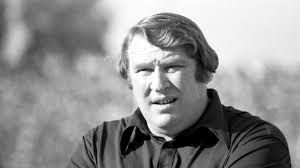
John Madden Sportscasting career
Television
CBS Sports (1979–1993)
In 1979, Madden started working for CBS as a color analyst. After doing lower-profile games in his early years, he and Pat Summerall were promoted to the network’s top football broadcasting pair in 1981, taking Tom Brookshier’s place. Madden had a number of announcer partners before joining up with Summerall on CBS, including Vin Scully, Dick Stockton, Frank Glieber, and Gary Bender. Madden and Summerall would go on to work together to call eight Super Bowls.
When Summerall wasn’t available (he was typically set to commentate on the U.S. Open tennis tournament during the first few weeks of the NFL season during the CBS years), Madden would join up with someone like Vin Scully and later Verne Lundquist. On January 23, 1994, during the 1993 NFC Championship Game, Madden reminded Summerall that while CBS may no longer have the NFL, at least they had the memories. This was their final CBS broadcast together. In 2005, when ABC aired its final Monday Night Football broadcast, Madden made a similar verbal decision.
Fox Sports (1994–2001)
Employees of CBS were allowed to leave their jobs when the Fox Network in 1994 acquired the rights to NFC games. As the largest name in football broadcasting, Madden had offers from Fox, ABC, and NBC that exceeded the $2 million annual salary cap for sportscasters. Additionally, NBC’s owner General Electric (GE) promised to designate Madden as its “worldwide spokesman” and GE Rail would construct a luxurious train for him. When Madden and Summerall joined Fox’s NFL coverage after almost joining ABC, the network gained the legitimacy to air what Rupert Murdoch referred to as “the crown jewel of all sports programming in the world”.
Madden received the highest yearly salary of any NFL player under his deal.[61] However, Fox reportedly lost $4.4 billion during the course of the eight-year contract it struck with the NFL toward the end of his tenure, and as a result, it has been attempting to reduce programming expenses. The 2003 value of Madden’s Fox deal was $8 million.
ABC Sports (2002–2005)
Al Michaels, a seasoned play-by-play broadcaster for Monday Night Football on ABC, hired Madden as a commentator in 2002. Madden allegedly earned $5 million annually.
NBC Sports (2006–2008)
Madden became the first sportscaster to have worked for all “Big Four” U.S. broadcast television networks when NBC Sports president Dick Ebersol announced in 2005 that Madden will offer color commentary for NBC’s Sunday night NFL games beginning with the 2006 season. The Seattle Seahawks-Tampa Bay Buccaneers Sunday Night Football game was scheduled for October 19, 2008, however NBC announced on October 13 that Madden would not be attending. This put an end to Madden’s 476-weekend streak of consecutive broadcast appearances.
Since he had taken a bus from Jacksonville to San Diego and would have had to go back to Florida before heading back to his home in Northern California, Madden chose to take the week off. For the game, Madden was replaced by Cris Collinsworth of Football Night in America, and he later made a comeback for the subsequent telecast on November 2, 2008, in Indianapolis (up until 2010, the NFL did not schedule Sunday night games for one week in October in order to avoid conflicting with the World Series, which was taking place roughly around the same time).
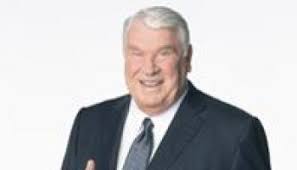
On February 1, 2009, Madden presided over the Arizona Cardinals vs. Pittsburgh Steelers Super Bowl XLIII game. On April 16, 2009, Madden formally announced his departure from the television booth. Collinsworth succeeded him.
Radio
While coaching the Raiders in the 1970s, Madden made his radio debut by calling into the program of legendary San Francisco radio host “The Emperor” Gene Nelson on station KYA. When Nelson moved to station KSFO, he followed him, and the call-ins continued even after Madden’s coaching career was over. Later, Madden appeared on KNBR. He started making calls to KCBS five days a week at 8:15 a.m. Pacific Time in 1997.
He kept phoning until Thanksgiving 2015, when he stopped due to heart surgery and other health issues. In 2017, he resumed his twice-weekly radio appearances on KCBS, airing on Mondays and Fridays at 9:15 a.m. In August 2018, he ceased making routine radio call-ins, citing a desire to free up his calendar from any commitments. The fact that KCBS referred to him as a “Senior Investigative At-Large Correspondent” suggests that he might occasionally phone in again. Additionally, Madden provided syndicated sports commentary on the American Westwood One radio network.
John Madden Legacy
Madden received favorable reviews and fourteen Sports Emmy Awards for Outstanding Sports Event Analyst thanks to his vivacious and colorful delivery. His announcing technique was accented by exclamations like “Boom!”, “Whap!”, “Bang!” and “Doink!” He also used a telestrator, which allowed him to overlay video footage with his light-penciled schematics of football plays. The telestrator was made popular by Madden’s usage of it, and it is now a standard feature of sports television broadcast.
For CBS and then Fox, Madden was well renowned for his work on the yearly Thanksgiving Day games. He would give the victorious team a turkey or turducken. Following the Thanksgiving Day game, he would also give turkey drumsticks to the players of the winning team, frequently bringing out a “nuclear turkey” with as many as eight drumsticks for the occasion. The drumsticks represented a peculiar interpretation of the “player of the game” honor. After moving to ABC in 2002, Madden ceased calling the Thanksgiving Day games, but the custom persisted.
The “Most Valuable” player in the contest receives the Galloping Gobbler from Fox, CBS, the NFL Network, and NBC (later). John Madden is now recognized by the NFL on Thanksgiving. It began in 2022. In 2022, a John Madden audio clip was played before each Thanksgiving game. After each game, a “Madden player of the game” will be announced.
John Madden All-Madden team
The “All-Madden” squad was a collection of players that Madden believed symbolized football and played the game the way he believed it should be played in 1984. Madden assembled the team on the advice of NFL coach John Robinson, a friend of his since elementary school. Up until his departure for ABC and Monday Night Football in 2001, Madden continued to choose the All-Madden team. In addition to including his “Haul of Fame” for his favorite players, Madden also produced special All-Madden teams for the 10th Anniversary, the Super Bowl, and the All-Madden team in 2000. In addition, Madden’s third best-selling book, Hey, Wait A Minute?, was titled All Madden. One Knee Equals Two Feet and I Wrote a Book).
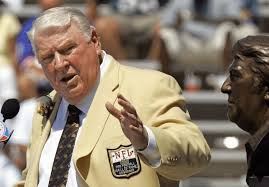
What exactly does the term “All-Madden” mean? There are many different things. For defensive linemen and linebackers, it’s about Lawrence Taylor wrecking havoc on the offense, Jack Youngblood playing with a broken leg, and Reggie White making the other guy wish he gave a little more to the church collection plate. It concerns a man with a filthy uniform, mud on his face, and grass in the helmet’s ear hole.
John Madden Other media
Film
Little Giants included a scene with Madden. Along with his then-broadcast partner Pat Summerall, he also portrayed himself as the host of the fictitious games in the movie The Replacements.
The Fox network aired All Madden, a documentary documenting Madden’s ascent to fame as an NFL coach and announcer, on December 25, 2021. The movie, which had its world premiere before the Cleveland Browns and Green Bay Packers’ Christmas Day game on Fox in Green Bay, features former and current NFL players.
John Madden Advertising and cameos
Madden appeared in numerous radio and television advertisements, including those for Ace Hardware, Verizon Wireless, Rent-A-Center, Miller Lite, Toyota, Sirius Satellite Radio, and “Tough Actin” Tinactin (the corporate sponsor of the Madden Cruiser). Particularly, the Miller beer adverts solidified the public’s perception of Madden as a bumbling yet endearing character.
Madden made an appearance in the 1999 Simpsons episode “Sunday, Cruddy Sunday”. In 1982, Jennifer Holliday performed on an edition of NBC’s Saturday Night Live that Madden hosted. Additionally, Madden appeared in the music video for the song “Stuck in a Moment You Can’t Get Out Of” by the Irish group U2. He made a similar cameo in the 1972 music video for Paul Simon’s song “Me and Julio Down by the Schoolyard”, where he tries to instruct some young players in football fundamentals.
Madden constructed Goal Line Productions in Pleasanton, California, to reduce travel time to the studios.
John Madden Football / Madden NFL video games
Beginning in 1988, Madden lent his name, voice, and creative expertise to the John Madden Football video game series, subsequently known as Madden NFL, developed by EA Sports and distributed by Electronic Arts. The series’ books have constantly sold well, to the point where they have even inspired TV shows that pit players against one another. Despite ending his career as a broadcaster in 2009, Madden continued to lend his name and creative input to the series up until his passing in 2021. The shows were so well-liked that he came to be known more to modern football fans as the face of Madden than as a Super Bowl-winning coach and broadcaster.
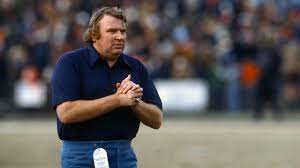
Madden saw the game as a teaching resource. Madden envisioned the application as a tool for training and assessing plays during early planning discussions with Electronic Arts founder Trip Hawkins in 1984. He claimed that Madden NFL was “a way for people to learn the game [of football] and participate in the game at a pretty sophisticated level” in 2012.
Following his passing, the EA Sports franchise continued to use his name, iconography, and license. On June 1, 2022, it was announced that Madden would appear on the covers of all editions of Madden NFL 23 as a tribute to his legacy. The cover of the next-generation version features a photo of Madden celebrating his victory as the head coach of the Oakland Raiders in Super Bowl XI, while the cover of the All Madden Edition is based on the cover of the series’ first game, John
John Madden Awards and honors
NFL
- Super Bowl XI winner (as head coach of the Oakland Raiders)
Broadcasting
- 16-time Emmy Award winner
- 1984 NSMA National Sportscaster of the Year
- Yahoo! Sports Top 50 All Time Network Television Sports Announcers (#2).
- 2002 Pete Rozelle Radio-Television Award winner
Halls of Fame
- Bay Area Sports Hall of Fame (class of 1991)
- Pro Football Hall of Fame (class of 2006)
- California Hall of Fame (class of 2009)
- 2010 NSMA Hall of Fame inductee
Personal life
Madden and Virginia Fields were wed on December 26, 1959, after meeting in a bar in Pismo Beach, California. They had two boys, Joseph and Michael, and they resided in Pleasanton, California. While Mike attended Harvard University and began his football career as a receiver, Joe played football at Brown University.
Two days prior to Madden’s passing, the couple celebrated their 62nd wedding anniversary.
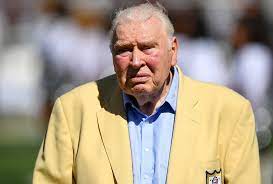
John Madden Aversion to flying
Although Madden’s dread of flying was well known, he did not become aware of it until far into his adult life. He had lost loved ones in the plane disaster that killed 16 football players, the team’s student manager, and a football supporter on October 29, 1960, while they were playing for California Polytechnic State University. He didn’t fly again until 1979, when he experienced his first panic attack on an aircraft with a Tampa, Florida, origin. However, Madden previously acknowledged in an interview that his main anxiety was claustrophobia and that he was not afraid of turbulence, flying, or heights.
A short clip that aired during Madden’s early 1980s hosting stint of Saturday Night Live showed him traveling to New York City by train to host SNL. Madden frequently traveled on Amtrak’s Lake Shore Limited in the middle of the 1980s, and the company let the well-known passenger to use the dining car whenever he wanted. In contrast, starting in 1987, Greyhound Lines gave Madden a special bus and drivers in exchange for publicity and speaking engagements, known as the Madden Cruiser. Motor Coach Industries is the company that creates the Madden Cruiser shells. Over the years, Outback Steakhouse and Walker Advantage Muffler have both sponsored the coach-bus program.
Even though the Pro Bowl was always played in Honolulu while Madden was a broadcaster, he never provided commentary for the game. Even when his play-by-play partner was on the broadcast, Madden never called a preseason game played outside of North America. After the September 11, 2001 attacks, Madden found an unexpected use for his bus in New York City when he gave former ice-skating champion Peggy Fleming transportation since her flight to Los Gatos, California, had been cancelled.
John Madden Death
On December 28, 2021, Madden passed away at his Pleasanton, California, home from an unidentified reason. He was 85 years old. In a statement announcing Madden’s passing, NFL Commissioner Roger Goodell stated that Madden “was football” and added, “There will never be another John Madden, and we will forever be indebted to him for all he did to make football and the NFL what it is today.”
John Madden Philanthropy
In September 2021, Madden will start providing six scholarships to his alma institution, Cal Poly, for kids graduating from various East Bay high schools, in addition to hosting an annual bocce event that benefits the Special Olympics and diabetes research.
The Madden family and Cal Poly announced in October 2022 that Madden has made a significant donation toward a $30 million football complex on the Cal Poly campus. The John Madden Football Center would provide the team’s coaches, players, and trainers with brand-new lockers, strength and conditioning equipment, a nutrition center, offices, training rooms, and a movie theater.
The building will be 30,000 square feet in size and is scheduled to debut in 2024. The entrance will be located next to the university’s memorial to the victims of the 1960 airplane tragedy, many of whom were Madden’s friends.
By the end of June 2016, Madden and Steve Mariucci had raised $5 million for the Northern California Special Olympics, the Juvenile Diabetes Research Foundation, and the Diabetes Youth Foundation through their co-hosted bocce event.
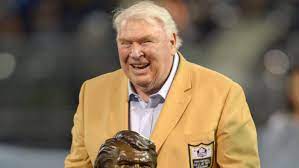
How many rings does John Madden have?
John Madden won how many Super Bowls? During his ten years as Raiders’ head coach, Madden only had one Super Bowl victory. The first Super Bowl victory for the team came during the 1976 campaign when they defeated the Vikings 32–14 at the Rose Bowl in Pasadena.
Is John Madden a Millionaire?
When he passed away in 2021, John Madden had a net worth of $200 million, according to a number of reports.
Is John Madden in the football Hall of Fame?
Madden was inducted into the Pro Football Hall of Fame in 2006 and passed away in December of 2021 at the age of 85.
Did John Madden ever marry?
John and his wife Virginia Fields had been together for 62 years at the time of his passing. The first wedding ceremony for the pair took place on December 26, 1959, within Santa Maria’s St. Mary of the Assumption Church.
How much is Madden worth?
As of 2023, the late John Madden had an estimated net worth of $200 million. One of the most successful football coaches in history, John Madden earned a sizable portion of his income as a head coach in the NFL.
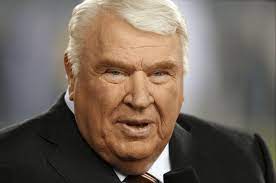
How much was Madden worth when he died?
When John Madden passed away in 2021, Celebrity Net Worth estimated his net worth to be $200 million. According to the website, he was one of the first celebrities to make more than $1 million annually through celebrity endorsements and the first broadcaster to earn a salary of $1 million.
Discover more from Labaran Yau
Subscribe to get the latest posts sent to your email.




